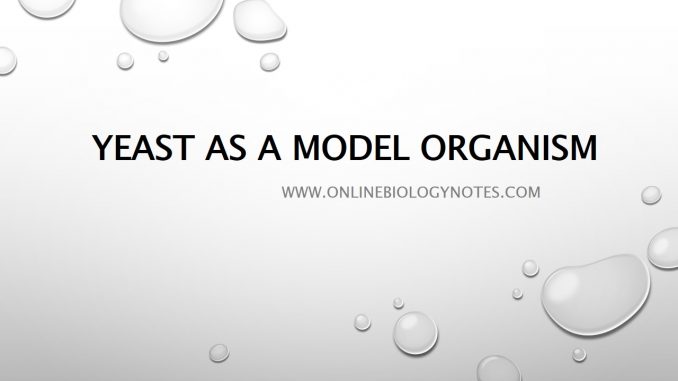
Yeast as a model organism in genetics, cell and molecular biology
- Budding yeast ( Saccharomyces cerevisiae ) is extensively used as a model organism for studying cellular processes in evolutionarily distant species, including humans. Studying the phylogenetic tree of life shows humans and yeast shared a common ancestor over a billons years ago. So, it is quite remarkable to know how a unicellular organism is related to human beings.
Some of the attributes which makes yeast as a model organism in genetics, molecular and cell biology are;
1. Simplest organization:
- Yeast is a simplest eukaryotic organism.
- Cell wall consisting of glucans, mannans and proteins
- Periplasmic space with hydrolytic enzymes
- Plasma membrane consisting of a phospholipid bilayer and many different proteins
- Nucleus with nucleolus
- Vacuole as storage and hydrolytic organelle
- Secretory pathway with endoplasmic reticulum, Golgi apparatus and secretory vesicles
- Peroxisomes for oxidative degradation
- Mitochondria for respiration
- Yeast combines many advantages of bacterial with eukaryotic genetics
2. Genomic study model:
- In 1996, Saccharomyces cerevisiae become first eukaryotic organism whose genome is fully sequenced.
- Genome of cerevisiae is well studied,consists of 12 million bps of DNA and contains about 6000 genes. Many genes important for human biology were discovered by studying their homologous in yeast cell.
- Similarly nearly 1000 yeast genes are members of orthologues genes of human which are associated with human disease. For most of these genes, they are functional in yeast but not in human, this indicates deletion mutation in these genes.
- Yeast nuclear genome has 16 chromosomes.
- Yeast genome is approximately three times larger than that of E. coli, although it is far more manageable than the genomes of more complex eukaryotes, such as humans.
- The yeast chromosomes contain both centromeres and telomeres sequence.
- Only a small percentage of yeast genes has introns; non coding sequence of RNA transcript.
3. Contains extra chromosomal DNA:
- Yeast contains extra chromosomal double stranded circular plasmid DNA
- more than one plasmid can be transformed in a yeast cell at a time.
4. Economic:
- Yeast are easy to culture and maintain in laboratory environment
5. Short generation time compared to other higher organisms.
6. Experimental study model:
- Gene manipulation is not complicated.
- Many fundamental aspects of eukaryotic cell such as DNA replication, transcription, translation, mutation, etc are understand on the basis of yeast study
- Yeast can be “transformed” with replicating plasmids. Transformation is efficient, although not as efficient as in E. coli.
- Yeast has an incredibly efficient systems for homologous recombination
7. Yeast consists of both haploid and diploid form:
- S. cerevisiae has two vegetative stages, haploids and diploids
- The haploid yeast genome consists of about 12,500 kbp
- Haploid and diploid form are interchangeable. Mating pairs of haploid cells fused to give diploid cell, while diploid cell on sporulation gives haploid cell. This makes genetic study easier. An exogenous DNA can be easily integrated into yeast genome.
Uses of yeast as model organism:
- To study ageing complexity of human beings:
- Yeast cells divides mitotically but the number of division in finite before cell dies(30-40 division), called replicative ageing. This is analogous to ageing profile of human stem cells.
- Yeast cell dies when it stay longer time in post mitotic stationary phase which is compared to human neuron of central nervous system.
- Human goes ageing because most human somatic cell do not express sufficient telomerase to prevent telomere attrition. This can be studied in yeast cell by knocking telomerase.
- To study the cell cycle
- Genetic analysis of mitochondrial biogenesis
- Use to study basic principles of eukaryotic gene expression and regulation such as lac operon, trp operon etc
- Use to study signal transduction pathway in higher organisms
- Different new technologies in genetics and systemic biology are developed by studying yeast as a model
- Use to study human genetic diseases
